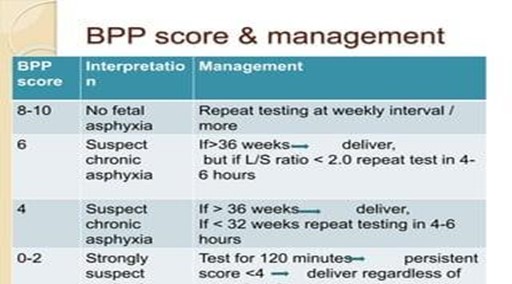A nurse is caring for a client in labor who has an internal fetal scalp electrode applied for continuous fetal heart rate (FHR) monitoring.
The nurse notes a pattern of late decelerations on the FHR tracing.
What is the priority nursing intervention?
Change the client's position.
Administer oxygen via face mask
Increase intravenous fluid rate.
Notify the health care provider.
The Correct Answer is D
Notify the health care provider. Late decelerations are a sign of uteroplacental insufficiency, which means that the blood flow and oxygen supply to the placenta and the fetus are compromised. This is a serious condition that can lead to fetal hypoxia and acidosis. The priority nursing intervention is to inform the health care provider who can assess the situation and decide on the appropriate course of action, such as delivery by cesarean section.
Choice A is wrong because changing the client’s position may not improve the blood flow to the placenta if there is a problem with the placenta itself, such as placental abruption.
Choice B is wrong because administering oxygen via face mask may not be enough to correct the fetal hypoxia caused by uteroplacental insufficiency.
Choice C is wrong because increasing intravenous fluid rate may not improve the blood flow to the placenta if there is a problem with the maternal blood pressure, such as hypotension from epidural analgesia.
Nursing Test Bank
Naxlex Comprehensive Predictor Exams
Related Questions
Correct Answer is ["E"]
Explanation
The test result is nonreactive after 40 minutes.Vibroacoustic stimulation (VAS) is the application of a vibratory sound stimulus to the abdomen of a pregnant woman to induce fetal heart rate (FHR) accelerations.VAS is typically used during a nonstress test (NST) to elicit fetal movement and reactivity when the baseline FHR variability is minimal or the test result is nonreactive after 40 minutes.VAS can shorten the testing time and reduce the incidence of non-reactive cardiotocography.
Choice A is wrong because the fetus’s presentation does not affect the use of VAS.
Choice B is wrong because VAS is not indicated for a fetus that has not moved for 40 minutes, unless the NST result is also nonreactive.
Choice C is wrong because minimal baseline FHR variability is not a sufficient indication for VAS, unless the NST result is also nonreactive.
Choice D is wrong because a history of stillbirth does not affect the use of VAS.
Correct Answer is B
Explanation
The client should count the baby’s kicks every day to monitor fetal well-being.A nonreactive nonstress test (NST) indicates that the fetal heart rate did not increase adequately with fetal movement, which may suggest fetal hypoxia or distress.A biophysical profile (BPP) is a combination of NST and ultrasound that assesses five parameters: fetal breathing, movement, tone, amniotic fluid volume, and NST.
Each parameter is scored 0 or 2, and the total score ranges from 0 to 10.A score of 8/10 or 10/10 is considered normal, while a score of 6/10 is equivocal and ≤ 4/10 is abnormal.A BPP score of 8/10 with a nonreactive NST means that the fetus has normal biophysical activities but may have chronic hypoxia.
Choice A is wrong because the client does not need to have another BPP in a week unless there are other indications of fetal compromise.The BPP may be repeated once or twice a week depending on the clinical situation.
Choice C is wrong because the client does not need to have an amniocentesis as soon as possible.
Amniocentesis is an invasive procedure that involves inserting a needle into the uterus to obtain amniotic fluid for analysis.It is usually done for prenatal diagnosis of genetic disorders or fetal lung maturity, not for fetal well-being.
Choice D is wrong because the client does not need to deliver the baby by cesarean section.Cesarean section is a surgical delivery that may be indicated for various maternal or fetal conditions, such as placenta previa, breech presentation, fetal distress, or failure to progress in labor.A BPP score of 8/10 with a nonreactive NST does not warrant a cesarean section unless there are other risk factors or complications.

Whether you are a student looking to ace your exams or a practicing nurse seeking to enhance your expertise , our nursing education contents will empower you with the confidence and competence to make a difference in the lives of patients and become a respected leader in the healthcare field.
Visit Naxlex, invest in your future and unlock endless possibilities with our unparalleled nursing education contents today
Report Wrong Answer on the Current Question
Do you disagree with the answer? If yes, what is your expected answer? Explain.
Kindly be descriptive with the issue you are facing.
